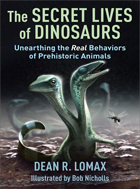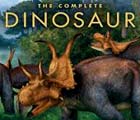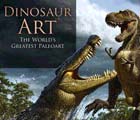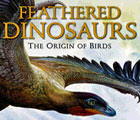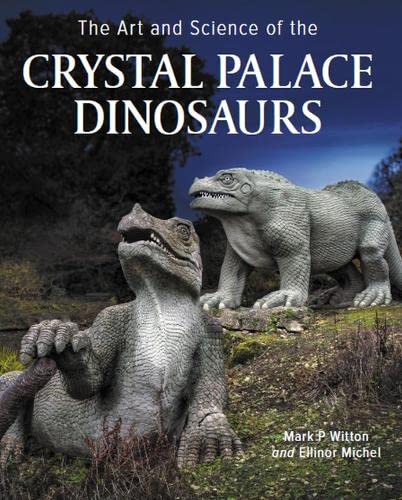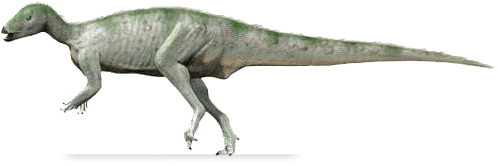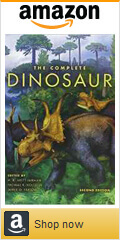Family Tree:
Dinosauria
Ornithischia
Genasauria
Neornithischia
Cerapoda
Ornithopoda
Hypsilophodontidae
Dinosauria
Ornithischia
Genasauria
Neornithischia
Cerapoda
Ornithopoda
Hypsilophodontidae
Pronunciation: hip-sih-LO-fo-DON-tuh-day
Author: Luis Dollo
Year: 1882
Meaning: Hypsilophodon family (see etymology)
Locomotion: Bipedal (2 legs)
Synonyms: Hypsilophodontinae (Nopcsa, 1928), Hypsilophodontia (Cooper, 1985)
Author: Luis Dollo
Year: 1882
Meaning: Hypsilophodon family (see etymology)
Locomotion: Bipedal (2 legs)
Synonyms: Hypsilophodontinae (Nopcsa, 1928), Hypsilophodontia (Cooper, 1985)
[Phylocode, 2021]Definition
The largest clade containing Hypsilophodon foxii (Huxley, 1869) but not Iguanodon bernissartensis Boulenger (Beneden, 1881) and Rhabdodon priscus (Matheron, 1869).
About
At one point, palaeontologists looked at Hypsilophodontidae as the nexus from which many of the major ornithischian groups sprung, and almost all 2-legged "bird-hipped" dinosaurs that weren't iguanodonts — from the Middle Jurassic to Late Cretaceous of Asia, Australia, Europe, New Zealand, North America and South America — were assigned here.
But, over recent years, its members have been shipped off to various other spots on the ornithischian family tree. Now, the only "hypsilophodont" left that palaeontologists could agree on is the group anchor Hypsilophodon, which would render Hypsilophodontidae — a family group with no family members — moot.
Despite that, some palaeontologists would still casually mention a "hypsilophontont-grade" or "hypsil-grade" critter from time to time. But what they were referring to is a small (1-2 meter), bipedal, swift-running, herbivorous ornithischian that's hard to classify with certainty, which is pretty much what hypsilophodonts have always been.
However, Hypsilophontontidae came roaring back into fashion in 2021 with the release of the "Phylocode" — a formal set of rules governing phylogenetic nomenclature — and was given a polished definition. Whether palaeontologists use it or not remains to be seen. Click here to search Dinochecker for hypsilophodonts.
Etymology
Hypsilophodontidae is derived from "Hypsilophodon" (the group anchor) and the Greek "idae" (family). Hypsilophodon itself is derived from "Hypsilophus" — a name stemming from Greek and proposed by Fitzinger for a type of Iguana with a "hypsi" (high) "lophos" (crest) running down its back, plus "odon" (tooth).
Further reading
• Dollo L (1882) "Première note sur les dinosauriens de Bernissart". Bulletin du Musée d'Histoire Naturelle de Belgique. 1: 161–180.
• Huxley TH (1869) "On Hypsilophodon, a new genus of Dinosauria". Geological Society of London, Abstracts of Proceedings, 204: 3-4.
• Boulenger GA (1881) "Sur l'arc pelvien chez les dinosauriens de Bernissart". [On the pelvic arch in the dinosaurs of Bernissart]. Bulletins de L'Académie royale de Belgique, 3eme série 1(5): 1-11
• Matheron P (1869) "Note sur les reptiles fossiles des dépôts fulvio-lacustres crétaces du bassin à lignite de Fuveau [Note on the fossil reptiles from the fluvio-lacustrine deposits of the Fuveau lignite basin]". Memoires de L'Academie Impériale des Sciences, BellesLettres et Arts de Marseilles, série 2, 26:781-795. [English translation by the Paleoglot website]
•
Weishampel DB and Heinrich RE (1992) "Systematics of Hypsilophodontidae and Basal Iguanodontia (Dinosauria: Ornithopoda)". Historical Biology 6(3): 159–184.
• Scheetz RD (1998) "Phylogeny of basal ornithopod dinosaurs and the dissolution of the Hypsilophodontidae". Journal of Vertebrate Paleontology, 18 (3, Suppl.): 75A.
• Winkler DA, Murry PA and Jacobs LL (1998) "The new ornithopod dinosaur from Proctor Lake, Texas, and the deconstruction of the family Hypsilophodontidae". Journal of Vertebrate Paleontology, 18 (3, Suppl.): 87A.
• Madzia D, Arbour VM, Boyd CA, Farke AA, Cruzado-Caballero P, Evans DC (2021) "The phylogenetic nomenclature of ornithischian dinosaurs. PeerJ 9:e12362 DOI: 10.7717/peerj.12362





